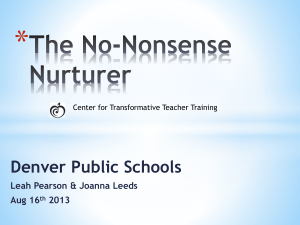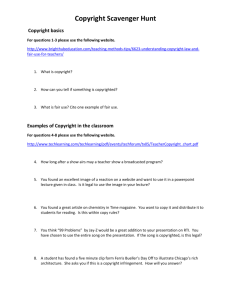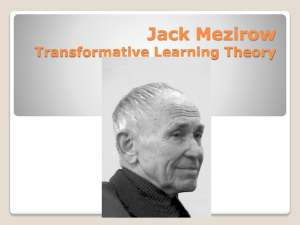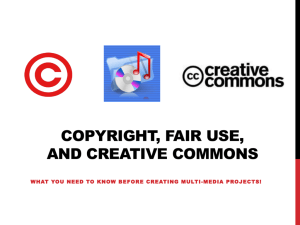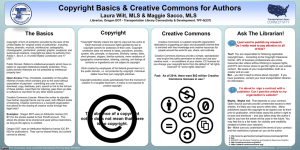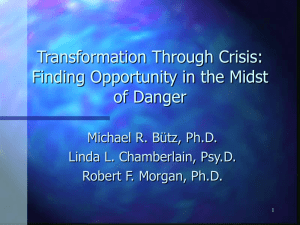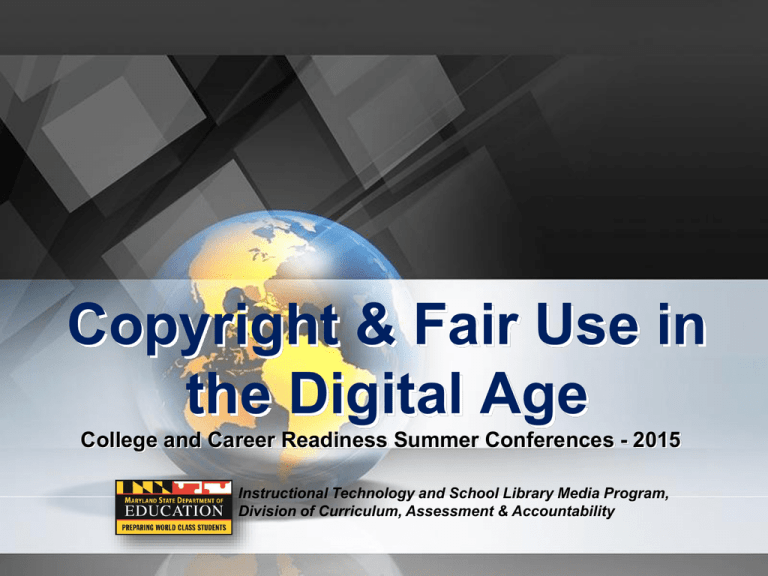
Copyright & Fair Use in
the Digital Age
College and Career Readiness Summer Conferences - 2015
Instructional Technology and School Library Media Program,
Division of Curriculum, Assessment & Accountability
Welcome &
Introductions
Outcomes:
Participants will …
-develop a deeper understanding of
copyright and “fair use” for
teaching and
learning
- apply a process for “judgment and
reasoning” to real world examples to
determine “fair use”
- develop an understanding of an alternative to
traditional “fair use
- extend this knowledge to their classroom
practice to help students understand the
importance of protecting intellectual property
and using it properly
Agenda:
• What is copyright?
• Fun Warm-up Activity – Identify These Folks!
• Learn About Copyright and “Fair Use” (Video)
• What makes a work “transformative?” – Group
Activity
• Review the “Tool for Supporting Fair Use Reasoning” Determining “Fair Use” – Group Activity
• What might this look like in the classroom?
(Video & Discussion)
• What is Creative Commons? (Video)
• Try some Creative Commons searches
• Wrap-up/Reflection
Activity #2
What is Copyright?
What is Copyright?
"to promote the Progress of Science and
useful Arts, by securing for limited
Times to Authors and Inventors the
exclusive Right to their respective
Writings and Discoveries.“
- United States Constitution, Article I Section 8
Copyrightable “works of authorship”
include:
• Literary works
• Musical works
(including words)
• Drama (including
music)
• Pantomime
• Choreographic
works
• Pictorial and
graphical works
• Sculptural works
• Motion pictures
and other
audiovisuals
• Sound recordings
• Architectural
works
How long does Copyright last?
• Copyright
originally lasted 14 years, plus an additional
14 if the Copyright registration was renewed - for a
total of 28 years.
• Now Copyright lasts 70 years after death of an
individual copyright holder.
• Corporations have managed to get Copyright extended
to 120 years from the year initial copyright issued.
• Public Domain
Activity #3
http://www.eonline.com/news/618553
http://www.celebuzz.com/2014-10-30/
http://thecurvature.com/
http://www.findagrave.com/
http://www.fanpop.com/
Warm-up: What do these folks have in
common?
Activity #4
Copyright Act of 1976 grants five
rights to a copyright owner:
1. The right to reproduce the copyrighted work
2. The right to prepare derivative works based upon
the work
3. The right to distribute copies of the work to the
public
4. The right to perform the copyrighted work publicly
5. The right to display the copyrighted work publicly
The Copyright Act also includes Section 107...
The Doctrine of Fair Use
Section 107 – Copyright Act of 1976
•Criticism
•Comments
•News Reporting
•Teaching
•Research
(including multiple
copies for classroom
use)
Determining Fair Use
• Nature of
Material
Fact or fiction, degree
of creativity?
• Purpose
Transformative?
• Portion
How much in relation
to the whole?
• Effect
Effect of use upon
potential market value?
“The Fifth Factor:
Transformative Use”
“When a user of copyrighted materials adds
value to, or repurposes materials for a use
different from that for which it was originally
intended, it will likely be considered
transformative use; it will also likely be
considered fair use. Fair use embraces the
modifying of existing media content, placing it
in new context.”
-Joyce Valenza, School Library Journal
http://blogs.slj.com/neverendingsearch/2008/04/01/fair-use-andtransformativeness-it-may-shake-your-world/
The Doctrine of Fair Use (Video)
Section 107 – Copyright Act of 1976
https://www.youtube.com/watch?v=8tWhKeb-fUQ&list=PLvzOwE5lWqhTbOCIFp_OxsN6nC-l20kMT&index=7
“The Fifth Factor:
Transformative Use”
“A derivative work is transformative if it uses a
source work in completely new or unexpected
ways. Importantly, a work may be
transformative, and thus a fair use, even when
all four of the statutory factors would
traditionally weigh against fair.”
- University of Minnesota
https://www.lib.umn.edu/copyright/fairuse
• Parody
• New Technologies
• Other Uses
Parody?
Source: http://nameberry.com/blog/a-cabbage-patch-namefest
Source: http://www.printmag.com/article/review-garbage-pail-kids-fromgrade-school-samizdat-to-art/
Source: Amazon.com
New Technologies
Source: https://www.youtube.com/watch?v=1tF2dF67Q2c
Source: https://www.youtube.com/watch?v=tJdDVun0Z6I
Other Transformative Uses
Source: https://soundcloud.com/blackoutmusicnl/state-of-mind-no-operative-3
Activity #5
Group Activity Transformative or Not?
AP Photo/Manny Garcia/ Shepard Fairey
http://www.allartnews.com/photographer-and-associated-press-drop-claims-against-each-other/
http://boingboing.net/2008/10/27/obey-alfred-e-neuman.html
http://en.wikipedia.org/wiki/Barack_Obama_%22Hope%22_poster
Group Activity Transformative or Not?
Web Poster Exhibition - Shepard Fairey posters for Barack Obama - http://www.posterpage.ch/exhib/ex216oba/ex216oba.htm
Activity #6
This …
https://www.ocps.net/lc/east/htc/mediacenter/Documents/FairUse.pdf
http://mediaeducationlab.com/code-best-practices-fair-use-media-literacy-education-0
Guidelines for Fair Use
versus this …
Determining Fair Use
Let’s review the “Tool for Supporting
the Fair Use Reasoning Process”
What decision will you make?
• Ask for Permission
• Claim Fair Use
• Pay a License Fee
• Choose Another Source (Creative Commons)
Source: http://copyrightconfusion.wikispaces.com/Reasoning
Activity- Determining Fair Use
Source: http://copyrightconfusion.wikispaces.com/Scenarios
• S1: For a media production course, students have created a music video using the
Beatles' song “Strawberry Fields Forever” that features teens lip-syncing
and playing air guitar along with footage of a teen couple walking hand-inhand in a graveyard. They post the video to You Tube.
• S4: A group of students create a documentary about John Lennon's role as an
anti-war activist, weaving old news clips from footage about the Vietnam
War and clips from various Lennon songs to show how his lyrics reflected
his beliefs about the war.
• S6: A team of elementary educators shows the Disney movie The Little Mermaid
to three classes of Grade 3 students on the day before winter break in the
school auditorium.
• S3: An educator uses a still image from the TV show Aliens in America in a
slide presentation for a conference. His purpose is to illustrate a
point about Pakistani immigration policy in the United States. He
posts the slides online.
Activity- Determining Fair Use
Source: http://copyrightconfusion.wikispaces.com/Scenarios
• S2: A teacher uses a copyrighted image, found on Flickr, adds the title of the
school play, and uses it on a T-shirt to promote the school's upcoming
dramatic production.
• S5: An educator embeds a political cartoon in one of her blog posts, commenting
on the cartoon's relevance to the troublesome school leadership in her
district.
• S7: Students on the Yearbook Committee create a DVD version of their yearbook
and sell it to make money for the class gift. As part of their opening
montage, they use AP photos and excerpts from popular music to capture
the climate of the times.
• S8: A high school social studies teacher downloads a You Tube video that
illustrates a key point about the U.S. Constitution's relevance to a current
news event and makes DVD copies to share with students who don't have
Internet access.
What Might this Look Like in
Your Classroom (Video)
How does the opening
discussion about fair use
prepare students for
examining the videos?
How are students
encouraged to defend
their choices and provide
evidence for their
conclusions?
Why is the fair use of
material an important
distinction for students to
understand?
Understanding “Fair Use” in a Digital World - https://www.teachingchannel.org/videos/teaching-students-fair-use
Activity #7
Creative Commons Movement
Creative Commons is a nonprofit organization that enables the sharing and
use of creativity and knowledge through free legal tools.
Features free, easy-to-use copyright licenses that provide a simple,
standardized way to give the public permission to share and use your
creative work — on conditions of your choice. CC licenses let you easily
change your copyright terms from the default of “all rights reserved” to “some
rights reserved.”
Creative Commons licenses are not an alternative to copyright. They work
alongside copyright and enable you to modify your copyright terms to best
suit your needs.
Wanna Work Together?
http://creativecommons.org/videos/wanna-work-together
Creative Commons Movement
(Video)
https://www.youtube.com/watch?v=BlhJUJ9DC4A
Creative Commons Licenses
Creative Commons Search
Source: http://search.creativecommons.org/
Google makes it easy to find usage rights
Source: http://google.com
Wrap-up & Questions?
Jay Bansbach, Program Specialist –
School Libraries, MSDE
carl.bansbach@maryland.gov

